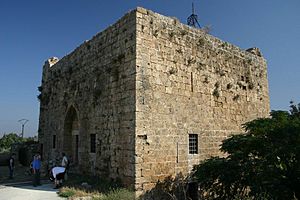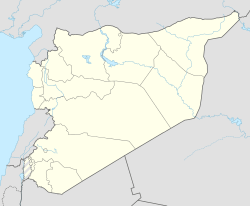Chastel Rouge facts for kids
|
Arabic: قلعة يحمور
|
|

Chastel Rouge
|
|
| Location | Syria |
|---|---|
| Region | Tartus Governorate |
| Coordinates | 34°48′44″N 35°58′14″E / 34.81222°N 35.97056°E |
Chastel Rouge, also known as Qal’at Yahmur (which means Castle of Yahmur in Arabic), is a small castle built by the Crusaders. It is located in the northwest of Syria. This castle was part of the County of Tripoli, a Crusader state. People also called it Castrum Rubrum in old Latin writings. You can find Chastel Rouge in the village of Yahmur. It's about 12 kilometers from Tartus and 10 kilometers from Safita. Other Crusader castles like Tortosa and Chastel Blanc are also nearby.
Contents
History of Chastel Rouge
Not much is known about how the Crusaders first took over and built up Chastel Rouge. This is because it was not as important as some other castles. Also, it's sometimes hard to find mentions of it in old records.
Early Days of the Castle
In 1112, a leader named Tancred gave the castle to Pons, Count of Tripoli. Later, a Frankish family called the Montolieu seemed to own it. They were like loyal helpers to the Counts of Tripoli. Chastel Rouge was part of a group of castles that protected the County of Tripoli. Other castles in this network included Crac des Chevaliers, Chastel Blanc, and Areimeh.
Changes in Ownership
Around 1177 or 1178, Raymond III gave Chastel Rouge to the Hospitallers. The Montolieu family received 400 bezants (an old type of money) as payment. In 1188, a famous leader named Saladin attacked the castle and destroyed it. The Crusaders likely got it back and kept it for about another 100 years. They finally lost it in 1289. This happened when the Mamluk sultan Qalawun was in charge.
What Chastel Rouge Looks Like
The village of Yahmur is on the flat land near the coast, between Tartus and Tripoli. Because of this, Chastel Rouge didn't have natural defenses like hills or cliffs. Many other castles were built on high places.
Castle Structure
The main part of the castle is a tall, strong tower called a donjon. It has two floors and measures about 16 meters long and 14 meters wide. This donjon is inside rectangular outer walls. These walls are about 42 meters long and 37 meters wide. There are also towers at the northwest and southeast corners of the outer walls. The first floor of the donjon used to have two levels separated by a wooden floor, but that floor is gone now. You can reach the upper floors using stairs that go along the walls, both inside and outside the donjon.
Building Periods
It's hard to say exactly when the castle was built. However, experts think it was built in two main stages. The first stage, which included the outer walls, was built in the early 1100s. The donjon, or main tower, was added later, in the early 1200s.
Older Discoveries
During digs at the castle, people also found old ruins from the Phoenician time. They also found writings from the Greco-Roman period. This shows that the area has been important for a very long time.
See also
 In Spanish: Castillo Rouge para niños
In Spanish: Castillo Rouge para niños


